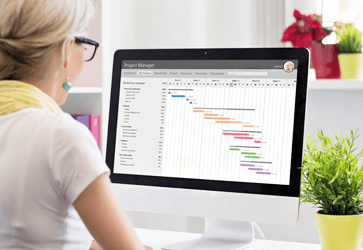 At the end of September, we had the opportunity to go to the Parc des Expositions at Porte de Versailles to attend the Paris Retail Week. Our participation in various conferences and workshops on the omnichannel theme, as well as our discussions with a number of exhibitors, led us to look in more detail at the following topics omnichannel challenges for the sales force.
At the end of September, we had the opportunity to go to the Parc des Expositions at Porte de Versailles to attend the Paris Retail Week. Our participation in various conferences and workshops on the omnichannel theme, as well as our discussions with a number of exhibitors, led us to look in more detail at the following topics omnichannel challenges for the sales force.
While the omnichannel customer journey is now a well-established and well-understood concept in retail jargon, it is often overlooked that it is only made possible by adapting and upgrading sales force tools. Retailers are currently investing massively in overhauling their management methods (business processes and information systems), and in particular in the supply chain, which represents a major challenge.
The changing role of the sales force
Indeed, if the aim of omnichannelity is to refocus the customer journey on the experience and the notion of service, as a relay and extension of digital the sales force must adapt accordingly and be able to rely on adequate technical resources thought out in their global ecosystem.
To guarantee the success of an omnichannel customer journey, two major thrusts stand out: the transformation of the role of the sales force, and increasingly connected management of the entire value chain. All of this is based on the digitalization of the point of sale, the customer experience and a data that is ever more reliable, easily accessible and better exploited.
Sharing tools in a single device
Today, many retail outlets focusing on premium service are equipped with sales tablets. The more all these tools are optimized and integrated into a single receptacle, the greater the productivity and responsiveness of the in-store sales force. The information and tools made available include :

- Access to information from the CRM software (profile of the customer facing the sales person, consumption history by channel, reference addresses, etc.) and to store and central inventories in real time.
- View and modify sales force schedules
- View business results and sales figures, as well as daily, weekly or monthly targets, individually or at the point of sale.
- Current events and offers on the brand's social networks
- Access to pricing and merchandising visuals at point of sale
- Possibilities for product demonstrations, mobile payment/collection or in-store orders for home delivery
Consolidating useful information for the sales force on a single device offers real advantages, not least in terms of time allocation on the sales floor with the customer. Tablets, which represent an intelligent global solution, make it possible to erase the boundaries between different departments: marketing, communication, after-sales service, human resources, strategy and operational management of the sales outlet (stocks, restocking, schedules, etc.).
With the transformation of the retail sector and the rise of omnichannel sales, the sales force is undergoing a transformation, at the crossroads of the company's various departments: the sales ceremony is being reinvented and enriched with multiple assets to perfect the knowledge and sense of customer service.
From a highly siloed organization in terms of functionalities or channels, with a tool dedicated to each action, we are now moving towards a decompartmentalized logic where the challenge is precisely to centralize and group all these actions withina single omnichannel tool.
The sales tablet: a bridge between head office and the sales force
The benefits are also perceptible at head office: operating costs are reduced, back office activities are facilitated, data flows more easily back to head office, and communication with sales outlets is much smoother in both directions.
 The head office has a duty to support and facilitate its sales force's working conditions as best it can, so that its attention is focused exclusively on its core business. developing sales and customer satisfaction. A sales force relieved of complex, repetitive or poorly thought-out procedures remains motivated and committed. Below is a non-exhaustive list of areas where the benefits of the tablet can be applied:
The head office has a duty to support and facilitate its sales force's working conditions as best it can, so that its attention is focused exclusively on its core business. developing sales and customer satisfaction. A sales force relieved of complex, repetitive or poorly thought-out procedures remains motivated and committed. Below is a non-exhaustive list of areas where the benefits of the tablet can be applied:
- Performance and Development
In addition to consulting their daily, weekly and monthly performance (metrics), salespeople can receive feedback, advice and coaching without waiting for their managers to physically visit them at the point of sale. For example, tools such as Microsoft Teams or Slack are used by salespeople to communicate in real time with their manager.
- Reward system
The challenge principle is very often aimed at the sales force. In these post-covid times, the sales team is expected not only to regain or even exceed their performance levels, but also to enjoy their work once again.
It's essential to regain collective energy and emulation around sales. That's why a sales incentive operation based on gamification is ideal. It helps restore group cohesion and a sense of belonging. One example is Etam, which regularly organizes challenges for its sales force. These challenges are often segmented by region and product (or range) or specific KPI (transformation rate, average basket, etc.).
- Apprenticeship and Training
E-learning programs are easily accessible from any device, thanks to Learning Management Systems (LMS) that manage an e-learning platform (360learning, Cosmic, Capterra are solutions widely used by French companies).
 Sales staff can follow these training modules (online and offline), accumulate points and receive rewards according to the number of training sessions they have completed. Knowing that one trained salesperson is worth two, the opportunity to make an LMS available to salespeople appears to be a real benefit. These LMSs enable companies to have a well-trained sales force, which means confident salespeople who convert prospects more easily.
Sales staff can follow these training modules (online and offline), accumulate points and receive rewards according to the number of training sessions they have completed. Knowing that one trained salesperson is worth two, the opportunity to make an LMS available to salespeople appears to be a real benefit. These LMSs enable companies to have a well-trained sales force, which means confident salespeople who convert prospects more easily.
Indeed, according to a CEGOS study, training is the number one factor impacting sales for 77% of sales managers. Here again, we can cite the Etam brand as an example, which provides its sales force with numerous training courses included in the teams' schedules. The range is broad, since the aim is to make sales staff aware of both the customer journey (by training them on customer reception processes or the new tools made available to enable new offers, such as pay by sms or try at home) and their own expertise (training on the different products, corsetier know-how, history of the house, etc.).
- HR Services
To facilitate their administrative work relating to human resources (salesperson profiles, internal mobility, expense reports, schedules), companies provide a special platform totally dedicated to these tasks. This saves time and facilitates exchanges. Compensation can also be managed via digital tools.
- Access to data CRM from the seat

Take personalized emailing, for example. Using their tablet, salespeople can send personalized recommendations to their customers. How do they do this? They compare the brand's available offer with the consumer's order history, select the products that could potentially appeal most to him/her, and then push them out in an email afterwards. Communication is therefore much more precise and impactful for the consumer. Sales reclaims its role as advisor, giving greater meaning to its work. The customer relationship is much more relevant, and the conversion rate is much higher.
Exchanging accurate data with head office is essential: this omnichannel strategy also represents an opportunity to centralize data from all channels for better monitoring and decision-making at corporate level. With the new omnichannel reality, the digital transformation of retail teams is more essential than ever. While the challenge is indeed to unify resources, the aim remains to combat standardization in favor of personalizing the customer experience and offering the most inclusive and intuitive environment possible for the sales force.
To read the second part of this article, follow this link.
By Léa Veryepe

